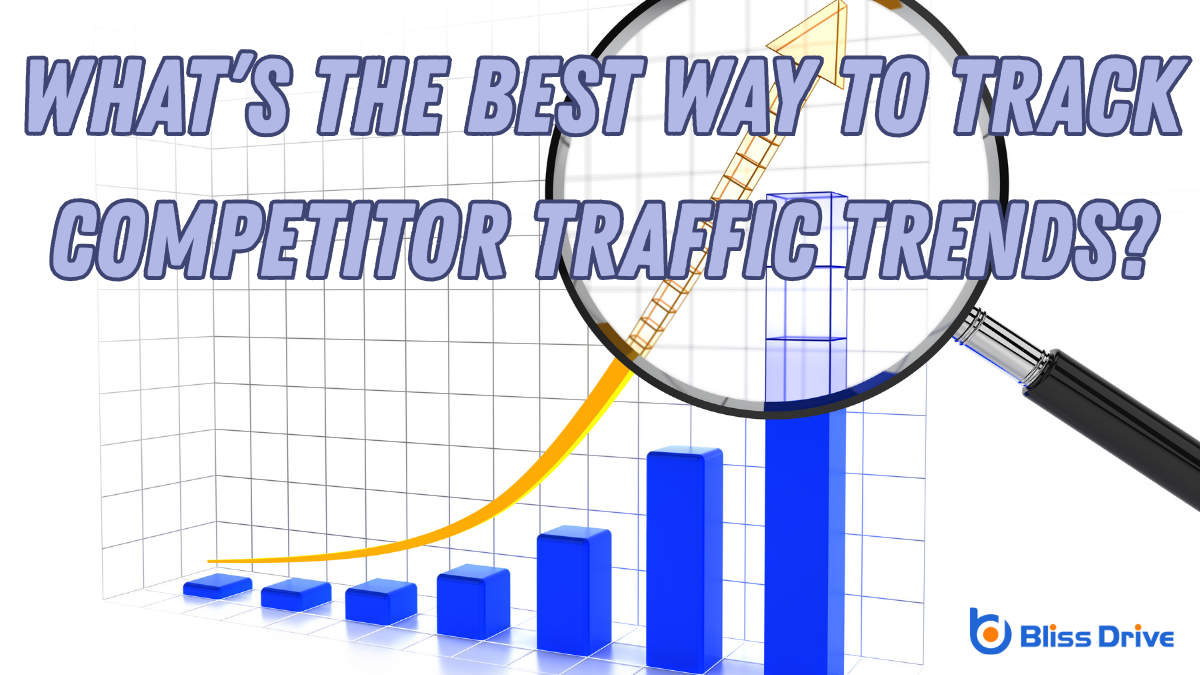Digital Marketing Services
Learn More About Us

To effectively track competitor traffic trends, focus on a blend of analytical tools and strategic metrics. You'll want to explore platforms like SEMrush and Ahrefs for thorough insights into traffic sources, user engagementThe level of interaction and involvement users have with social media content., and demographics. Keep an eye on Google TrendsA tool to analyze the popularity of search queries over time. for changes in your competitors' traffic patterns. Discover how competitive intelligence software and heatmaps can enhance your understanding of their strategies. Curious about integrating these insights into your own business approach?
Why bother with competitor traffic analysis? You might think your business is doing well, but understanding your competitors' traffic can reveal opportunities you’re missing. By analyzing how much traffic they receive, you gain insights into their customer engagementThe level of interaction and involvement a customer has with a brand. strategies. This helps you pinpoint what works and what doesn’t in your industry.
Competitor traffic analysis allows you to see patterns and trends. You’ll understand market demands and position yourself to meet them effectively. This knowledge helps you craft better marketing strategies and improve your content.
It’s not just about copying what others do; it’s about learning from them to enhance your own approach. By keeping an eye on competitor traffic, you guarantee your business remains competitive and relevant in an ever-changing market.

When tracking competitor traffic, you should start by analyzing their traffic sources to understand where their visitors are coming from.
It's also essential to monitor engagementThe interactions that users have with a brand’s content on social media. metrics like bounce rate, page views, and time on site to gauge how effectively they're engaging their audience.
To effectively analyze traffic sources and track competitor traffic, it's crucial to identify key metrics that provide valuable insights. Start by examining where your competitors’ traffic originates. Look at direct traffic, referrals, organic search, paid searchAdvertising on search engines, where advertisers pay to have their ads appear in search results., and social media. Understanding these sources helps you determine which channels drive the most visitors to their site.
Focus on metrics like unique visitors, bounce rate, and average session duration to gauge the quality of the traffic they're attracting. Discovering the percentage of traffic from each source can reveal their strategy and help you adjust yours.
Also, pay attention to changes over time. If you notice a spike in their referral trafficVisitors who come to a website through an affiliate's promotional efforts., investigate the source. By analyzing these metrics, you’ll uncover how competitors attract and maintain their audience.
How do you effectively monitor engagement metrics to understand competitor traffic better?
Start by identifying key metrics like bounce rate, average session duration, and pages per session. These indicators reveal how visitors interact with a competitor’s site. A high bounce rate might suggest content isn’t resonating, while a long session duration could indicate engaging material.
Use tools like SimilarWeb or SEMrush to gather data on these metrics. Keep an eye on social media engagementThe interaction between a brand and its audience on social media, including likes, comments, shares,... too; likes, shares, and comments can signal successful content.
Don’t forget to track email open ratesThe percentage of recipients who open an email. and click-through rates if they’re available. By analyzing these elements, you’ll gain insights into what’s working for your competitors, allowing you to adjust your strategy and improve your own site’s performance.
Google Trends offers a powerful tool for gaining valuable insights into your competitors' traffic patterns. By typing in specific keywordsWords or phrases that users type into search engines to find information. related to your industry, you can uncover rising trends your competitors might be riding.
It’s not just about seeing what’s popular; you can compare search volumes over time. This allows you to spot seasonal trends and understand when competitors might experience spikes or dips in traffic.
Dive deeper by selecting regions and timeframes to see where and when competitors gain traction. This geographic data reveals where you might focus marketing efforts.
Google Trends also lets you explore related queries, helping you identify new content opportunities. Use these insights to sharpen your strategy and stay one step ahead of the competition.
While Google Trends provides a broad overview, SEO tools like SEMrush and Ahrefs offerThe specific product or service being promoted by affiliates. a more detailed analysis of competitor traffic.
You can dive deep into keyword rankingsThe position at which a website appears in the SERP. and uncover which strategies are driving traffic to your competitors' sites. These tools let you analyze organic and paid search traffic, giving you insights into their successful keywords and ad strategies.
SEMrush and Ahrefs also provide data on your competitors' backlink profiles, so you can see who's linking to them and why. This information helps you identify potential opportunities for your own link-building efforts.

Although SEO tools provide valuable insights into search engine performance, exploring social media monitoringTracking social media platforms for mentions of a brand, competitors, or relevant topics. tools offers a different perspective on competitor analysisEvaluating the strengths and weaknesses of competitors’ SEO strategies.. You’ll gain a direct view into how competitors engage with their audience and the type of content that resonates.
Tools like Hootsuite, Sprout Social, or Brandwatch allow you to track competitor mentions and sentiment across platforms like TwitterA microblogging and social networking service where users post and interact with messages known as "..., FacebookA social networking site where users can post comments, share photographs, and links to news or othe..., and InstagramA photo and video-sharing social networking service owned by Facebook.. It’s essential to see what posts garner the most interaction, as this can clue you into successful strategies.
To effectively understand your competition's online performance, leverage web analyticsThe measurement, collection, analysis, and reporting of web data to understand and optimize web usag... platforms that offer in-depth data analysisThe process of inspecting, cleaning, transforming, and modeling data to discover useful information.....
These platforms provide insights into how competitors attract and retain their audience, helping you identify opportunities and threats. By using these tools, you can stay ahead in your industry without the guesswork.
When choosing competitive intelligence software, focus on key features that align with your business needs.
Guarantee the tool provides accurate data, as this is essential for making informed decisions.
Evaluate each option based on criteria like ease of use, integration capabilities, and support services to find the best fit.
Employing competitive intelligence software can give you a significant edge by revealing essential insights into competitor traffic trends. To make the most of this technology, understanding its key features is vital.
First, real-time tracking allows you to monitor competitors' traffic changes as they happen, giving you the ability to act promptly.
Second, extensive analytics provide a detailed breakdown of traffic sources, engagement metrics, and visitor behavior, helping you identify what strategies are working for your competitors.
Finally, benchmarking tools let you compare your performance against industry standards, so you can identify gaps and opportunities for improvement.
These features empower you to make informed decisions and stay one step ahead of the competition, ensuring your business thrives in a competitive market.
Although employing competitive intelligence software offers numerous advantages, the accuracy of the data it provides is paramount for making effective decisions.
You can't rely on faulty insights when planning your next strategic move. Accurate data guarantees you're not just chasing shadows but understanding real trends in competitor traffic. It helps you identify genuine opportunities and threats, allowing for informed decisions that can shape your business strategy.
When the data's accurate, you can confidently adjust your marketing efforts, anticipate competitor moves, and effectively allocate resources. Always verify the software's data accuracy by comparing it with other reputable sources.
Selecting the right competitive intelligence software requires a clear understanding of your business needs and objectives. You’ll want to make certain the tool aligns with these goals, providing relevant insights into competitor traffic trends.
Consider these criteria when choosing:
Choosing wisely empowers you with strategic insights.

When you want to gain insights into how competitors' websites perform, utilizing heatmaps can be a powerful tool. Heatmaps visually represent user interactions, highlighting where visitors click, scroll, or hover. By analyzing these patterns, you can identify which areas of a competitor’s site draw the most attention and which are overlooked. This data helps you understand what elements engage users effectively.
To start, observe click maps to see popular links and calls to action. Scroll maps reveal how far down users venture on a page, indicating content that holds interest.
Pay attention to movement maps that show cursor paths, reflecting visitor engagement. By interpreting these insights, you’ll better grasp competitor behavior, enhancing your ability to refine your own website strategies.
Understanding competitor traffic trends can transform your business strategy by revealing valuable insights into market dynamics. You can spot patterns, identify gaps, and seize opportunities.
Here’s how to incorporate these insights effectively:
To effectively track competitor traffic trends, combine multiple tools and metrics for an all-encompassing view. Immerse yourself in key metrics and use platforms like Google Trends and SEO tools for valuable insights. Don't forget to leverage social media monitoring and competitive intelligence software for a broader perspective. Heatmaps can reveal user interactions on competitor sites, helping you refine your strategy. Incorporate these insights into your business strategy to stay ahead and make informed decisions.
